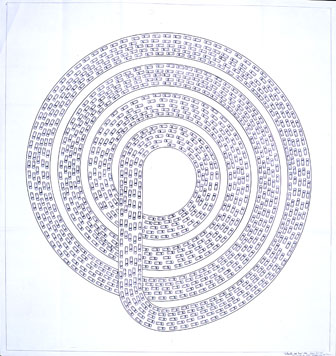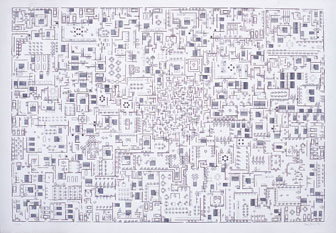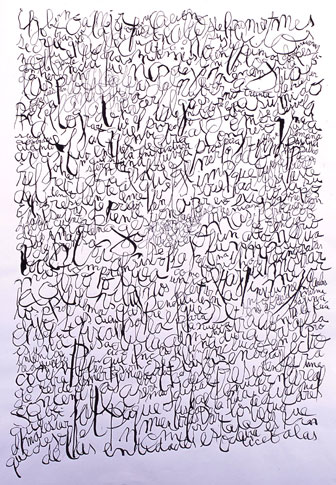Artists: León Ferrari
León Ferrari's versatile practice encompasses collages made with Christian iconography, oriental erotica and camouflage, installations made with living birds in cages, board games, bottles and manikins, photographs intervened with texts written in Braille, written paintings, deformed calligraphies and electronic art.
In 1962 he began a series of written drawings that he called Escrituras Deformadas (Deformed Writings). To this group of calligraphies belongs El árbol embarazador (1964): the first of his works to be openly critical of Christianity. With Carta a un General (1963) Ferrari began to produce works that were politically active in intent but distinctly visual in composition, an approach that might be described as pictorial conceptualism. In 1965 he submitted the controversial sculpture La Civilización Occidental y Cristiana for exhibition at the Di Tella Institute. This work, depicting Christ crucified on a US bomber, was censored from the show in 1965 and caused antagonism once again during his retrospective exhibition at Centro Cultural Recoleta in Buenos Aires in 2005.
Ferrari and his family were forced to exile in Brazil at the start of the military dictatorship in 1976. While living in São Paulo he worked on a series of acoustic metal sculptures, created architectural plans to be reproduced using heliography and began to research new media such as photocopy, mail art, and videotext, alongside a group of experimental Brazilian artists. From his series of heliographs we present a selection in this exhibition.
The heliographic print Cidade is from a series of plans depicting urban areas called by the artist Arquitecturas de la locura (Architectures of Madness) which were produced when Ferrari was living in São Paulo. A set of subversive architectures filled with anonymous, chaotically behaving characters, Ferrari's plans signal the absurdity of modern life, and the complex relationship between madness and order in the urban setting. As in other works within the series Ferrari has given this work a title in Portuguese language, reflecting the fact that this was a work produced while he was living in Brazil (rather than his native Argentina) and thus acknowledging the particular cultural reality surrounding him at that time.
This improbable urban plan depicts a labyrinthine city seen from above. Inside houses numerous beds occupy various spaces: queues of beds in corridors, beds meeting and colliding, beds with queues of people arriving and departing. Although inspired by São Paulo (with its vast network of roads, bridges and spaghetti junctions; filled with queues of traffic and innumerable people) this plan also acts as a wider critique of the established parameters of order in political power dicourses.
The original composition of this imprint was hand-assembled with architects' symbols and print-sets. As with the rest of the series, this artwork is a reproduction, made using heliography (a technique employed by architects to reproduce blueprint plans). The original work can thus be multiplied ad infinitum, reflecting Ferrari's desire to give unlimited access to his heliographic plans, and thus to excise any material value from their status as works of art. As a means of distributing these works, Ferrari folded each reproduced plan and sent it through the post.
Bairro is one of the larger plans within the Arquitecturas de la locura series and contains a variety of symbols and scenes. As if the artist were observing the city with a magnifying glass in order to uncover detailed information, this image seems to zoom-in upon one section of Cidade.
The work depicts a section of an imaginary city. In this, one of the largest works in the series, the image is more tightly focused, representing a neighbourhood. This is a Gods-eye perspective on a dwarfed city, where hundreds of impossible situations are seen from above. This neighbourhood contains corridors and rooms displaying fragments of hectic but incomprehensible life: rooms with beds at the centre are converted into places of pilgrimage or corporate meeting rooms; rows of people queue up to arrive while other rows of people seem to be simply waiting for something to happen; clusters of beds create cross-shaped patterns; identical figures sit round large board-room tables.
Ferrari finds inspiration in the maddening traffic of the megalopolis to create a narrative of distressing chaos in Autopista del Sur. This work takes its title from the short story by Argentine writer Julio Cortázar describing the absurdity of a peculiar circumstance in which hundreds of cars get trapped for months in a traffic jam. The critique and ironic take on contemporary urban life that underlies the short story are present in the visual construction of this work, which depicts an endless road in the form of a spiral packed solid with cars, with no beginning and no end.
As in the rest of this series of works, he employs ready made printing stamps (in this case that of a car) to create the image, and repeats it methodically in order to produce a narrative that profoundly subverts the established visual order.
From the series Escrituras deformadas, the calligraphy presented in this show is a transcription of a poem by Jorge Luis Borges into a pictorial object. Subtitled Elogio de la Sombra, the poem dates from 1969 when Borges was losing his sight, describing the process of becoming blind. In this work Ferrari uses the poem both as idea and material. The handwriting is highly curvilinear and irregular, closer to drawing than to writing, and it is laid on a layer of marks made on the page with white lacquer. These signs create a sense of depth and also provide a texture to the surface, turning it into a text to be touched, to be read with our fingers.
Two of the sculptures presented, A19-Poliuretano rosa (A19-Pink Polystyrene), made of wire and pink polystyrene foam and A 29-Atado con alambre, bones and wire, are the most recent pieces by Ferrari in this exhibition, both dated 2006. Alongside these pieces, another three dimensional work, Ajedrez (Chess) of 2004 represents another fundamental strand of Ferrari's body of work, in which table games are turned into impossible constructions charged with humour and irony, by means of replacing the traditional components with small figurines representing Christian religious icons, animal toys, devils and images from popular culture.
|
|

Autopista del Sur / Southern Highway
1980 - 2000
Heliographic print
100 x 100 cm
Courtesy of UECLAA (University of Essex Collection of Latin American
Art)

Sin título / Untitled
1986
off-set lithograph on paper
70 x100 cm
Courtesy of UECLAA (University of Essex Collection of Latin American
Art)

Sin titulo / Caligrafía
Untitled / Calligraphy
2000
Indian ink and newsprint on paper
50 x35 cm
Courtesy of UECLAA (University of Essex Collection of Latin American
Art) |